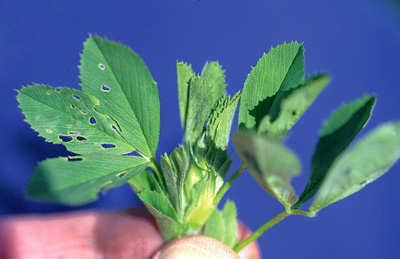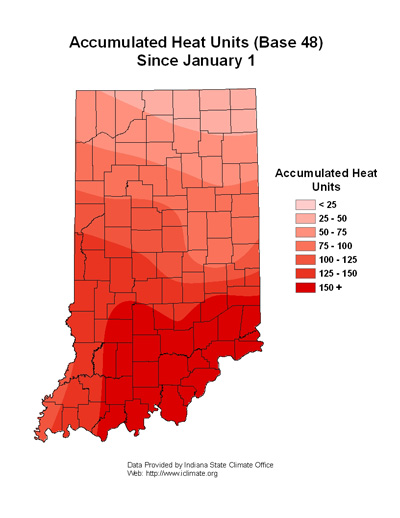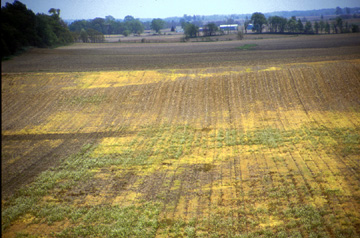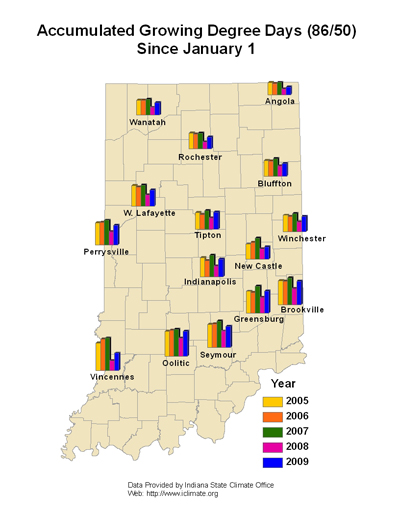Pest & Crop Newsletter, Entomology Extension, Purdue University
Unpredictability is Predictable For Insect Pests - (John Obermeyer and Christian Krupke)
- Yes, there will be crop loss from insects this year.
- Insect trends help one assess risks, not accurately predict them (sound like a financial advisor?).
- Prophylactic pest management can be driven by paranoia and misinformation.
We are often asked this time of year to forewarn of impending doom from insects that will devour our crops this coming season. There are 2 primary factors driving this need for bad news: Media likes headlines and marketers like to sell product. To their disappointment, we can predict pest outbreaks no better than the weather, the ultimate deciding factor on insect growth, development, and reproduction. Be assured, for those doom-and-gloomers, sometime and somewhere from something this season there will be crop loss. Being able to foretell just when, where, how much, and from what just isn’t possible at this time.
We know that some insects, (e.g., corn rootworms), are perennial threats in many areas of the state. Yet even they have their down years. Last spring’s wet conditions caused tremendous mortality of larvae the soil, this was quite evident from the anemic rootworm beetle populations during the summer. With fewer adults, it stands to reason that fewer eggs were laid last season, meaning lower risk to this year’s corn. Apparently some haven’t gotten this message or they know something that we don’t, because as never before have we gotten so many questions about using soil insecticides in combination with Bt-RW corn. This dual mode-of-action to control rootworms has many potential ramifications, aside from being a more costly way to achieve the same end result as either product alone. Remember, both soil insecticides and Bt-RW corn continue to offer excellent protection from root feeding. There is no evidence that resistance to either strategy has occurred. So until you hear otherwise, don’t fix what isn’t broken….
Granted, some insects have had predictable trends, e.g., soybean aphid, by invading northern/central Indiana soybean fields in odd years. 2009 is an odd year, should we prepare for the onslaught? One problem is that this every-other-year trend is that it has only existed since 2000, their first known presence in the United States...so not much history here. Note also that this trend has broken-down in the northern Corn Belt and seems to be softening here. Surprisingly there were a few isolated outbreaks in northern Indiana last year, who would’ve predicted that? Recreational spraying of sub-economic level of aphids in soybean, especially if dry conditions persist, has some potential devastating consequences…which are quite predictable (i.e. killing all the predators will promote spider mite outbreaks).
Folks, such as y’all, that come to the Pest&Crop on a regular basis to get up-to-date information on pests, their development, and potential impact on our crops makes this effort worthwhile. We have been encouraged throughout the years by your questions, comments, and field updates as situations develop. Thanks for your continual support of IPM, keep up the good work and the calls coming. Happy Scouting!
![]()
Alfalfa Weevil Damage Beginning in Southern Indiana - (Christian Krupke, John Obermeyer, and Larry Bledsoe)
- Alfalfa weevil activity has begun.
- Scouting should begin now in southern Indiana.
- Damage and heat unit accumulations are the basis of management decisions.
David Trotter, Clark County CES, did some slogging through foot high alfalfa in extreme southern Indiana and found 44% weevil tip feeding. Richard Huntrods, at Feldun Purdue Agricultural Center near Bedford, reported about 20% feeding in 8-inch alfalfa. Both observed very small larvae in the terminal tips. Thanks to their efforts, we know it’s time to start scouting alfalfa for weevil damage in the southern counties of Indiana.
Field scouting for alfalfa weevil damage should begin when approximately 200 heat units, base 48°F, have accumulated from January 1 (see following Heat Unit map for locations near you). Sampling a field to determine the extent of alfalfa weevil damage and average stage of weevil development is best accomplished by walking through the field in an “M-shaped pattern.” Ten alfalfa stems should be examined in each of 5 representative areas of the field for a total of 50 stems from the entire field. Consider that south-facing slopes and/or sandy soils warm sooner and should be included in the sampling. Each stem should be examined for: (1) evidence of tip feeding by alfalfa weevil larvae; (2) maturity of the stem, i.e. pre-bud, bud and/or flowers; and (3) stem length. The average size (length) of weevil larvae should also be noted. Although large alfalfa weevil larvae are relatively easy to find, small larvae are difficult to see; thus very close examination of leaves may be required to detect “pin-hole” feeding, small black fecal pellets and small off-white larvae.
By utilizing heat unit accumulation data to determine when sampling should begin and when management action should be taken, producers can get the greatest economic return. If the application of an insecticide is required early in the weevil season, producers have the option of using a material that has good residual action. Later in the season, short residual insecticides should be used and producers should pay close attention to harvest restrictions. Management guidelines, which are based on heat unit accumulations, will be given in next week’s Pest&Crop.
![]()
Weeds and Cutworms - (Christian Krupke, John Obermeyer, and Larry Bledsoe)
- Black cutworm have been arriving.
- Moths are seeking weedy fields to lay their eggs.
- Early herbicide applications can help manage this pest.
As shown in this week’s “Black Cutworm Adult Pheromone Trap Report,” this insect has begun its arrival into the Midwest. Female cutworm moths are particularly attracted to winter annuals, such as chickweed and mustards in which to lay their eggs. Fields that are showing plenty of green are at highest risk for cutworm damage. Corn and soybean are among the cutworm’s least favorite foods, it just so happens that these are the only plants remaining by the time larvae have emerged and weeds have been killed. Research has shown that cutworm larvae starve if weeds are treated with tillage or herbicide 2-3 weeks before crop emergence – an example of a case when controlling weeds can help manage insect pests.
![]()
Click here to view the Black Cutworm Adult Pheromone Trap Report





